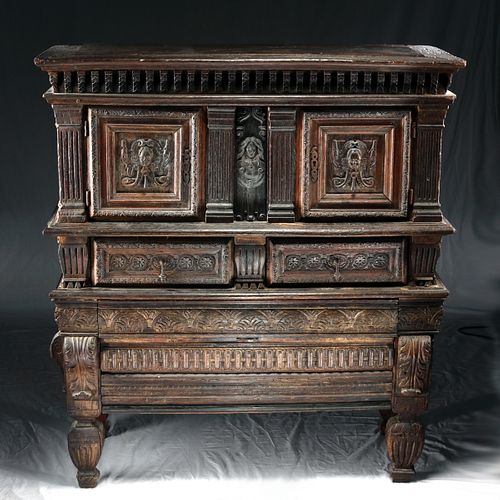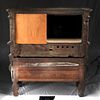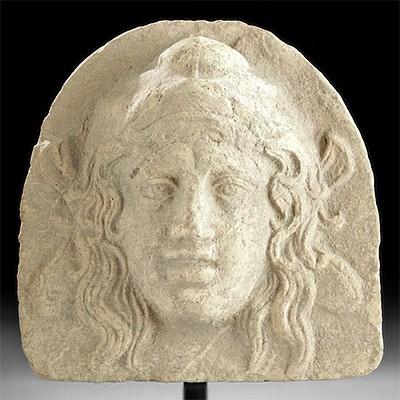Massive 15th C. French Carved Wooden Chest, 2 part
Lot 172a
About Seller
Artemis Fine Arts
686 S Taylor Ave, Ste 106
Louisville, CO 80027
United States
Selling antiquities, ancient and ethnographic art online since 1993, Artemis Gallery specializes in Classical Antiquities (Egyptian, Greek, Roman, Near Eastern), Asian, Pre-Columbian, African / Tribal / Oceanographic art. Our extensive inventory includes pottery, stone, metal, wood, glass and textil...Read more
Categories
Estimate:
$9,000 - $15,000
Absentee vs Live bid
Two ways to bid:
- Leave a max absentee bid and the platform will bid on your behalf up to your maximum bid during the live auction.
- Bid live during the auction and your bids will be submitted real-time to the auctioneer.
Bid Increments
| Price | Bid Increment |
|---|---|
| $0 | $25 |
| $300 | $50 |
| $1,000 | $100 |
| $2,000 | $250 |
| $5,000 | $500 |
| $10,000 | $1,000 |
| $20,000 | $2,500 |
| $50,000 | $5,000 |
| $100,000 | $10,000 |
| $200,000 | $20,000 |
About Auction
By Artemis Fine Arts
Feb 27, 2020
Set Reminder
2020-02-27 10:00:00
2020-02-27 10:00:00
America/New_York
Bidsquare
Bidsquare : VARIETY SALE | Antiquities & Ethnographic Art
https://www.bidsquare.com/auctions/artemis-gallery/variety-sale-antiquities-ethnographic-art-4920
Around the world & back in time - be amazed at the treasures you will find. Antiquities from Egypt, Greece, Italy and the Near East, Asian, Pre-Columbian, African / Tribal / Oceanic, Native American, Spanish Colonial, Russian Icons, Fine Art, much more! Artemis Fine Arts info@artemisfinearts.com
Around the world & back in time - be amazed at the treasures you will find. Antiquities from Egypt, Greece, Italy and the Near East, Asian, Pre-Columbian, African / Tribal / Oceanic, Native American, Spanish Colonial, Russian Icons, Fine Art, much more! Artemis Fine Arts info@artemisfinearts.com
- Lot Description
Northern Europe, France / Duchy of Brittany, ca. 1450 to 1490 CE. A massive, beautifully preserved late Gothic armoire / cupboard, made of dark, heavy oak, with two upper cabinets and two drawers at center. The chest stands on four elaborate, tiered feet. Much of the surface is ornately carved, with floral and linear motifs, including the sturdy legs. Columnar motifs delineate the spaces between the drawers and cabinets. Each drawer and cabinet has a carved, hinged door and heavy teardrop-shaped iron handle that hangs down from an iron ring at its center, ready to be lifted and pulled to reveal the interior. Each cabinet door face is carved with a seraphim head with broad wings spread behind it. The seraphim were venerated as the highest choir in the angelic hierarchy. Between these doors is a carved woman wearing a diamond-shaped pendant necklace that looks similar to many known cloissonne pendants from this time period. She has flowing hair and her hands clasped in front of her stomach. Size: 20" L x 51.7" W x 47.5" H (50.8 cm x 131.3 cm x 120.6 cm)
Starting in the 14th century, northern European nobles began to furnish their manorial households with elaborate wooden furniture. The rise of the "solar", or private room where the family lived and slept (as opposed to the medieval hall, the single interior room where nearly all activities took place), meant that people suddenly had multiple rooms in need of furniture, and tables, chairs, cupboards, and chests began to proliferate. Indeed, taxation records indicate that this was the first time period in post-Roman Europe that people really began to value furniture. For example, Chaucer records descriptions of wooden furniture in the 14th century "Canterbury Tales". Armoires - also known as buffets or cupboards - were the main piece of Gothic-era domestic furniture. They were initially made for travel between manorial properties but, by the time this one was made, they had become too large and luxurious to move easily. Instead, an armoire like this one likely graced a bedroom and was used to keep valuable items.
Accompanying the piece is a handwritten notecard that reads, "Very rare Brittany chest circa 1450 to 1490. Owned by Sir Lawrence Edmund Governor of Eleuthera Island. Exhibited at Buccaneers Club in the 1950s. Appraised in the 1960s for 35,000.” Our research indicates that there is a Sir Edmund Wickham Lawrence who was the Governor-General of St. Kitts and Nevis.
See an example ca. 100 years later that has a similar form at the Royal Ontario Museum in Toronto, Canada: https://artsandculture.google.com/asset/cabinet/dQHYteq0lfx1PQ
Provenance: private Honolulu, Hawaii, USA collection, purchased from an estate in Taos, New Mexico, USA
All items legal to buy/sell under U.S. Statute covering cultural patrimony Code 2600, CHAPTER 14, and are guaranteed to be as described or your money back.
A Certificate of Authenticity will accompany all winning bids.
We ship worldwide and handle all shipping in-house for your convenience.
#148898Given its age and material, this chest is in excellent condition. Please note that it is in two pieces (as it was made), with the top and bottom fitting together to give the appearance of a single piece of furniture. There are small losses from peripheries. Two loose components are kept in the lower right drawer, one scrollwork from an edge, the other a decorative panel from one side. The two wooden undersides of the upper cabinets are newer replacements, as is the back of the right side upper cabinet, but otherwise the wood all appears to be original. The left side drawer cannot be opened. The left side upper back is lost. Otherwise there is light wear commensurate with age, including small chips, nicks, and scratches.Condition
- Shipping Info
-
All shipping is handled in-house for your convenience. Your invoice from Artemis Gallery will include shipping calculation instructions. If in doubt, please inquire BEFORE bidding for estimated shipping costs for individual items.
-
- Buyer's Premium



 EUR
EUR CAD
CAD AUD
AUD GBP
GBP MXN
MXN HKD
HKD CNY
CNY MYR
MYR SEK
SEK SGD
SGD CHF
CHF THB
THB


















